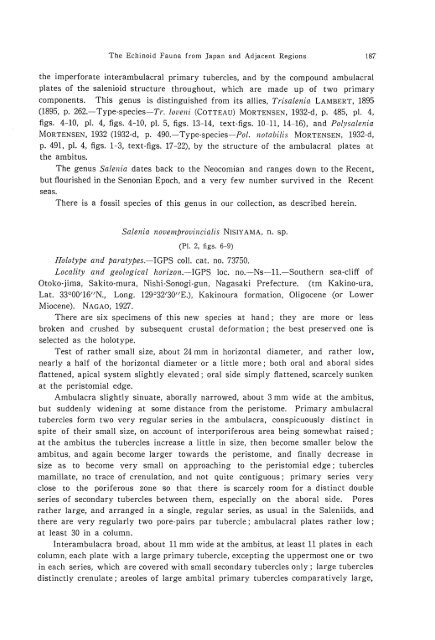the echinoid fauna from japan and adjacent regions part i
the echinoid fauna from japan and adjacent regions part i
the echinoid fauna from japan and adjacent regions part i
Create successful ePaper yourself
Turn your PDF publications into a flip-book with our unique Google optimized e-Paper software.
The Echinoid Fauna <strong>from</strong> Japan <strong>and</strong> Adjacent Regions 187<br />
<strong>the</strong> imperforate interambulacral primary tubercles, <strong>and</strong> by <strong>the</strong> compound ambulacral<br />
plates of <strong>the</strong> salenioid structure throughout, which are made up of two primary<br />
components. This genus is distinguished <strong>from</strong> its allies, Trisalenia LAMBERT, 1895<br />
(1895, p. 262.-Type-species-Tr. loveni (COTTEAU) MORTENSEN, 1932-d, p. 485, pI. 4,<br />
figs. 4-10, pI. 4, figs. 4-10, pI. 5, figs. 13-14, text-figs. 10-11, 14-16), <strong>and</strong> Polysalenia<br />
MORTENSEN, 1932 (1932-d, p. 490.-Type-species-Pol. notabilis MORTENSEN, 1932-d,<br />
p. 491, pI. 4, figs. 1-3, text-figs. 17-22), by <strong>the</strong> structure of <strong>the</strong> ambulacral plates at<br />
<strong>the</strong> ambitus.<br />
The genus Salenia dates back to <strong>the</strong> Neocomian <strong>and</strong> ranges down to <strong>the</strong> Recent,<br />
but flourished in <strong>the</strong> Senonian Epoch, <strong>and</strong> a very few number survived in <strong>the</strong> Recent<br />
seas.<br />
There is a fossil species of this genus in our collection, as described herein.<br />
Salenia novemprovincialis NISIY AMA, n. sp.<br />
(PI. 2, figs. 6-9)<br />
Holotype <strong>and</strong> paratypes.-IGPS coil. cat. no. 73750.<br />
Locality <strong>and</strong> geological horizon.-IGPS loc. no.-Ns-11.-Sou<strong>the</strong>rn sea-cliff of<br />
Otoko-jima, Sakito-mura, Nishi-Sonogi-gun, Nagasaki Prefecture. (tm Kakino-ura,<br />
Lat. 33°00'16/1N., Long. 129"32'30/lE.), Kakinoura formation, Oligocene (or Lower<br />
Miocene). NAGAO, 1927.<br />
There are six specimens of this new species at h<strong>and</strong>; <strong>the</strong>y are more or less<br />
broken <strong>and</strong> crushed by subsequent crustal deformation; <strong>the</strong> best preserved one is<br />
selected as <strong>the</strong> holotype.<br />
Test of ra<strong>the</strong>r small size, about 24 mm in horizontal diameter, <strong>and</strong> ra<strong>the</strong>r low,<br />
nearly a half of <strong>the</strong> horizontal diameter or a little more; both oral <strong>and</strong> aboral sides<br />
flattened, apical system slightly elevated; oral side simply flattened, scarcely sunken<br />
at <strong>the</strong> peristomial edge.<br />
Ambulacra slightly sinuate, aborally narrowed, about 3 mm wide at <strong>the</strong> ambitus,.<br />
but suddenly widening at some distance <strong>from</strong> <strong>the</strong> peristome. Primary ambulacral<br />
tubercles form two very regular series in <strong>the</strong> ambulacra, conspicuously distinct in<br />
spite of <strong>the</strong>ir small size, on account of interporiferous area being somewhat raised;<br />
at <strong>the</strong> ambitus <strong>the</strong> tubercles increase a little in size, <strong>the</strong>n become smaller below <strong>the</strong><br />
ambitus, <strong>and</strong> again become larger towards <strong>the</strong> peristome, <strong>and</strong> finally decrease in<br />
size as to become very small on approaching to <strong>the</strong> peristomial edge; tubercles<br />
mamillate, no trace of crenulation, <strong>and</strong> not quite contiguous; primary series very<br />
close to <strong>the</strong> poriferous zone so that <strong>the</strong>re is scarcely room for a distinct double<br />
series of secondary tubercles between <strong>the</strong>m, especially on <strong>the</strong> aboral side. Pores<br />
ra<strong>the</strong>r large, <strong>and</strong> arranged in a single, regular series, as usual in <strong>the</strong> Saleniids, <strong>and</strong><br />
<strong>the</strong>re are very regularly two pore-pairs par tubercle; ambulacral plates ra<strong>the</strong>r low;<br />
at least 30 in a column.<br />
Interambulacra broad, about 11 mm wide at <strong>the</strong> ambitus, at least 11 plates in each<br />
column, each plate with a large primary tubercle, excepting <strong>the</strong> uppermost one or two<br />
in each series, which are covered with small secondary tubercles only; large tubercles<br />
distinctly crenulate; areoles of large ambital primary tubercles comparatively large,












